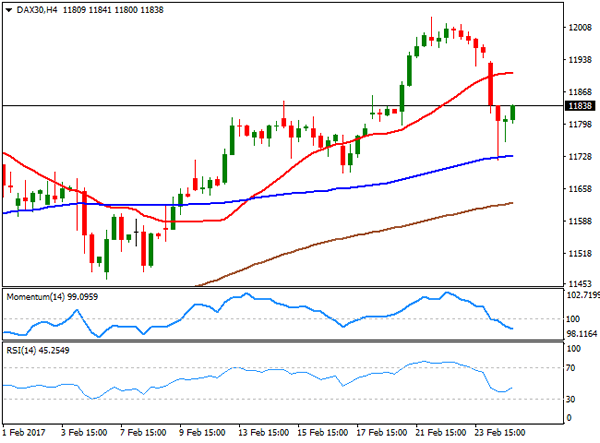EUR/USD
The American dollar closed the week with a soft tone across the board, despite Friday’s sharp recovery, higher weekly basis, however, against the EUR, as the common currency remains undermined by political uncertainty in the region, centered at the time being in the upcoming French presidential elections, as Marine Le Pen, the most popular candidate, has pledged to call for a "Frexit" referendum, should she win the election. Confidence in the USD was eroded by an unclear FED on when the next rate hike will come, and the absence of economic announcements from the new US administration.
On Friday, the EUR/USD pair advanced up to 1.0617, but quickly retreated below the 1.0600 figure, to close the week around 1.0560, despite US data was far from encouraging. Consumer confidence fell in February for the first time since the US election, according to the University of Michigan’s monthly survey, as the index came in at 96.3 from January’s 98.5. Sales of new homes during January rose at a slower-than-expected pace, as sales climbed by 3.7% to an annualized pace of 555,000. The upcoming week will be quite a busy one in the US, starting with the release of Durable Goods Orders for January this Monday, expected to have improved from December’s figures.
From a technical point of view, the pair is biased lower, as Friday’s spike was contained by a daily descendant trend line coming from this year high of 1.0828, whilst the price settled below the 23.6% retracement of the post-US election rally, at 1.0565, the immediate resistance. In the daily chart, indicators have turned south within negative territory, whilst the price remained well below bearish 20 and 100 SMAs all the week, supporting some further slides on a break below 1.0520. In the 4 hours chart, the price settled around a flat 20 SMA, whilst the Momentum indicator has turned sharply lower and is about to cross its 100 level, while the RSI indicator presents a modest bearish slope around 45, also supporting a bearish extension on a break below the mentioned support.
Support levels: 1.0520 1.0470 1.0440
Resistance levels: 1.0590 1.0635 1.0660
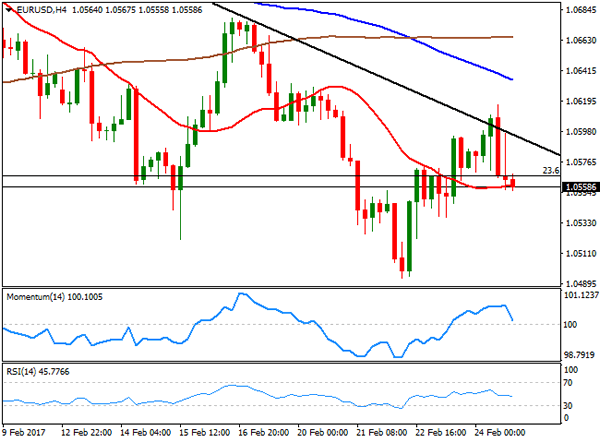
USD/JPY
The USD/JPY pair fell down to 111.93 on Friday to settle a few pips above the 112.00 level, undermined by plummeting US Treasury yields and a soft tone in equities all through the day. Asian and European ones closed in the red, while US indexes managed to post marginal gains, after being under pressure for most of the session. Tepid US data, with worse-than-expected US New Home Sales and Michigan Consumer Confidence, also weighed on the pair. Yields closed at their lowest levels for the year, with the 10-year not benchmark down to 2.32% and the 30-year note yield falling to 2.96% from previous 3.02%. In the daily chart, the price has closed the day below its 100 DMA for the first time since early October, whilst the RSI indicator heads south around 40. The Momentum indicator, however, remains flat around its 100 level, whilst the pair has bottomed this February around 111.60, meaning that it will take a break below this last to confirm a bearish extension. In the 4 hours chart, the price is well its moving averages, whilst the Momentum indicator heads south at 1-week lows and the RSI consolidates around 30, in line with the longer term technical outlook.
Support levels: 111.90 111.60 111.20
Resistance levels: 112.50 113.00 113.45
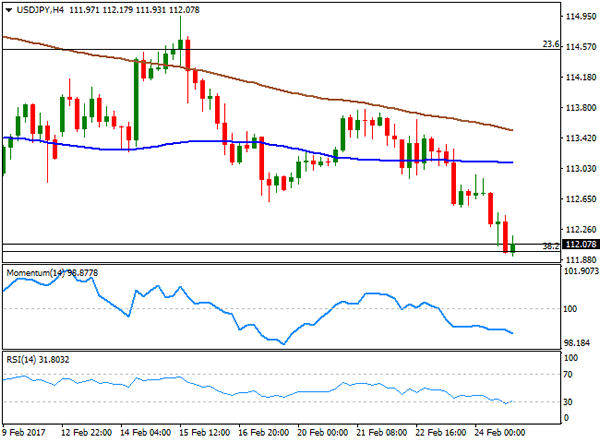
GBP/USD
The GBP/USD pair closed at 1.2460, little changed for a third consecutive week. The pair retreated from a weekly high of 1.2569, bounded in its usual range, despite positive news coming from the UK, as according to the British Banks’ Association, mortgage approvals surged to their highest in a year in January, up to 44,657 mortgages in January, up from 43,581 in December. During the upcoming days, the House of Lords will discuss amendments for the Brexit bill particularly focused on guarantee the rights of EU citizens to stay in the UK after Brexit and to ensure the Parliament has a binding vote on the final departure deal before it’s too late for it to be changed, an effective veto. If PM Theresa May is defeated by parliamentarians the Pound will likely come under selling pressure. Technically, the pair remains neutral, although with an increasing bearish potential, as the price settled below a bearish 20 SMA, whilst technical indicators have turned modestly lower around their mid-lines. In the 4 hours chart the neutral stance persists, with the price moving back and forth around its 20 SMA and technical indicators heading nowhere around their mid-lines. The pair has been finding buying interest around 1.2380, while February low converges with the 50% retracement of the latest bullish run at 1.2345, the level to break to confirm a bearish breakout.
Support levels: 1.2430 1.2380 1.2345
Resistance levels: 1.2485 1.2530 1.2565
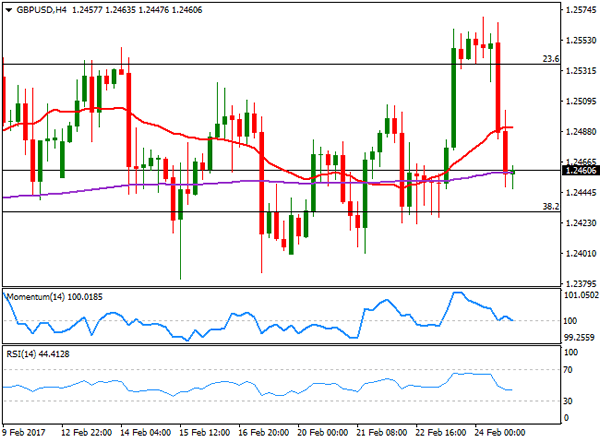
GOLD
Gold prices surged to their highest in over three months, after FED’s Minutes failed to confirm a rate hike for March and over increasing uncertainty over the economic impact of US’s new administration policies. Spot gold surged up to $1,260.07 a troy ounce and closed the week at 1,256.62, above the 61.8% retracement of the post-US election slump. Political uncertainty in Europe and the US maintain safe-haven assets on demand, with gold and yen poised to extend their gains during the upcoming days. Gold’s daily chart shows that the price accelerated further above a bullish 20 DMA, but met some selling interest around the 200 DMA, the immediate resistance at 1,260.10. In the same chart, the Momentum indicator has lost upward strength, but remains within positive territory, whilst the RSI indicator maintains its bullish slope within overbought readings. In the 4 hours chart, the price is far above all of its moving averages, with the 20 SMA having accelerated its advance, now around 1,240.00 and technical indicators holding within overbought territory.
Support levels: 1,253.20 1,242.50 1,230.00
Resistance levels: 1,261.10 1.273.20 1,281.70
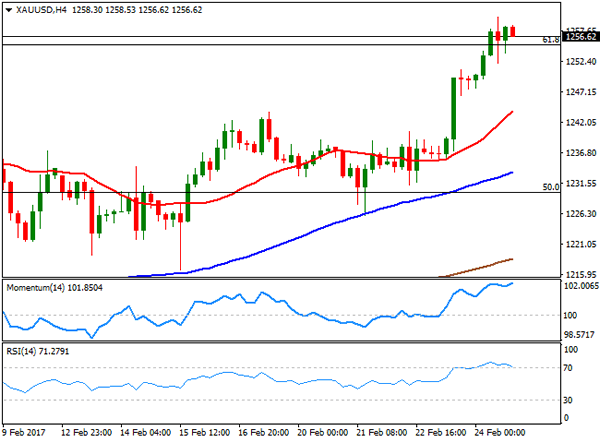
WTI CRUDE
Crude oil prices retreated on Friday, with West Texas Intermediate crude oil prices settling at $54.00 a barrel, undermined by news that non-OPEC countries which joined efforts with the organism to trim output, has compiled with around 50% of the cut pledged last November. Increasing US production and stockpiles also weighed on prices this past week. On Friday, Baker Hughes reported that the number of active US rigs drilling for oil rose by 6 to 597 this week, the fifth consecutive weekly advance. Crude has been range bound pretty much since last December, leaving a neutral stance in the daily chart, as the price holds above a horizontal 20 DMA, while technical indicators head nowhere around their mid-lines. In the shorter term, and according to the 4 hours chart, the price settled a few cents below a modestly bearish 20 SMA, whilst technical indicators diverge from each other within neutral territory, as the Momentum aims higher, whilst the RSI lower.
Support levels: 53.40 53.00 52.50
Resistance levels: 54.75 55.30 56.00
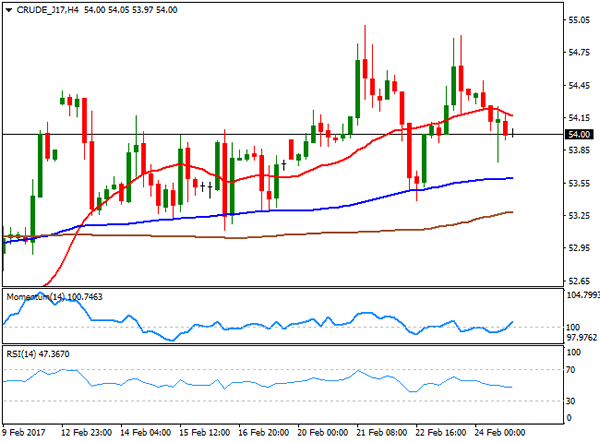
DJIA
Following a soft opening, US indexes managed to close the day marginally higher and at all-time highs, with the Dow Jones Industrial Average up 11 points or 0.05%, and settling at 20,821.76, its eleventh consecutive record in-a-row. The Nasdaq Composite added 9 points on Friday and closed at 5,845.31, while the S&P advanced 3 points, to 2,367.34. The positive momentum in sentiment eased following comments from US Treasury Secretary Mnuchin, indicating that the new policies will take longer-than-expected to be implemented, but speculative interest took the early slide as a buying opportunity keeping the euphoria alive, at least within equity traders. Banks were the worst performers, following the lead of their European counterparts, with Goldman Sachs Group topping losers’ list, down by 1.53%, followed by JPMorgan Chase that shed 0.88%. Energy-related equities suffered from lower oil prices, with Exxon Mobil down 0.86%. Wal-Mart lead gainers, up 1.51%, followed by Intel that added 0.97%. From a technical point of view, the daily chart shows that technical indicators have lost upward strength, turning horizontal in extreme overbought levels, still far from supporting a bearish corrective move, whilst the index is far above bullish moving averages. In the 4 hours chart, the index closed above a still bullish 20 SMA, after briefly falling below it, the RSI indicator resumed its advance around 59, but the Momentum indicator eases within positive territory, indicating that the market will need a strong trigger to resume buying.
Support levels: 20,730 20,692 20,637
Resistance levels: 20,839 20,860 20,900
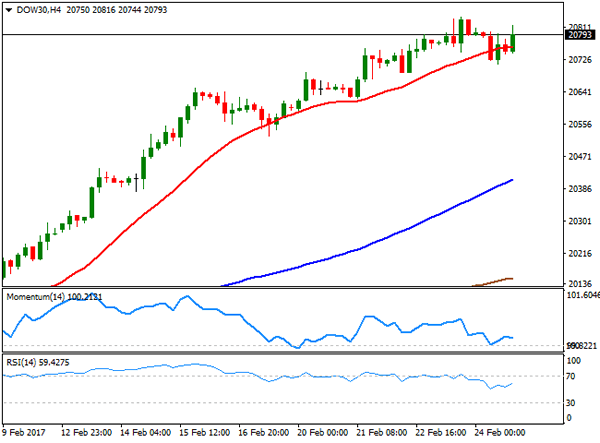
FTSE 100
The FTSE 100 closed at 7,243.70, down by 27 points, weighed by the Royal Bank of Scotland as the bank posted a loss of 6.96 billion pounds for 2016, its ninth consecutive year of losses. The bank lost 4.49% topping losers’ list, followed by mining and energy equities, with Rio Tinto down 3.00% and BHP Billiton losing 2.93%. International Consolidated Airlines Group was the best performer, up 4.46%. The index trimmed most of its daily losses ahead of the close, but bouncing from a fresh two-week low on Pound’s weakness. Technical readings in the daily chart show that the benchmark closed above its 20 DMA and that the Momentum indicator holds flat above its 100 level, while the RSI indicator kept correcting overbought conditions, now around 55, all of which limits chances of a sustainable decline. In the 4 hours chart, the 20 SMA gains bearish strength above the current level, now around 7,282 whilst technical indicators bounced from oversold readings, maintaining their bullish slopes, but still below their mid-lines, indicating that a recovery above the mentioned resistance is required to confirm further gains ahead.
Support levels: 7,238 7,200 7,165
Resistance levels: 7,282 7,315 7,342
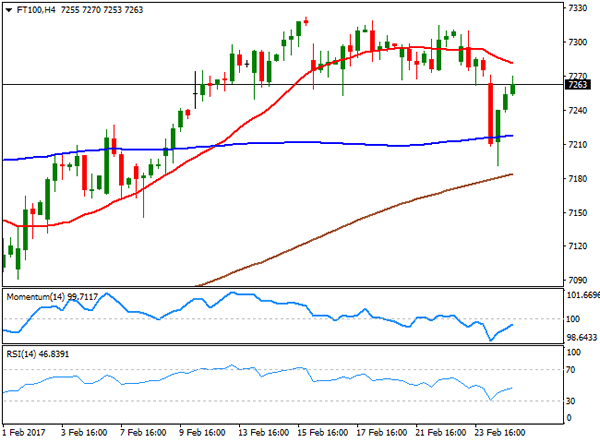
DAX
The German DAX closed the week at 11,804.03, down on Friday 142 points or 1.20%, with financials and auto-makers leading the way lower. Banks were among the worst performers, with Commerzbank down 3.22% and Deutsche Bank shedding 2.74%, after the Royal Bank of Scotland reported a £6.96 billion pounds’ lost for 2016. Only 5 components closed with gains, with Deutsche Lufthansa being the best performer, up 0.58%. The sharp retracement in the German benchmark is a first sign of warning against the dominant bullish trend, but it´s still not enough to confirm a sustainable reversal. In the daily chart, the index bounced strongly after testing its 20 SMA, currently at 11,737, while the Momentum indicator continues consolidating within positive territory, and the RSI indicator retreated from overbought readings, heading south now around 57. In the 4 hours chart, the index bounced strongly from a bullish 100 SMA, but established far below its 20 SMA, the Momentum indicator maintains its bearish strength within negative territory, while the RSI turned modestly higher around 45, in line with the longer term perspective at supporting a bearish extension only with a break below the mentioned support.
Support levels: 11,781 11,737 11,692
Resistance levels: 11,860 11,902 11,945
